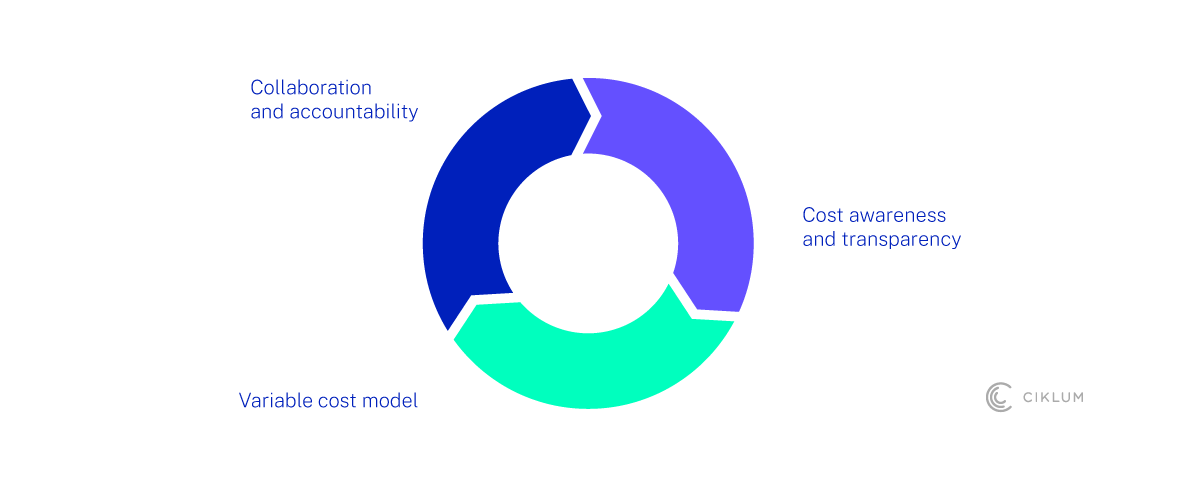- Key Takeaways:
- How FinOps Can Help Businesses Optimize Cloud Costs
- Core Principles of FinOps
- FinOps Best Practices for Cloud Cost Optimization
- Embedding FinOps in Business Operations
- Tools and Solutions for Cloud Cost Management
- Challenges and Considerations in FinOps Implementation
- In Summary: What Does The Future Hold for FinOps?
Key Takeaways:
- FinOps is critical for businesses to optimize their cloud spend management.
- Collaboration between finance, technology, and business teams is essential.
- Implementing FinOps leads to significant cost savings and operational efficiency.
- Continuous monitoring and automation are key components of effective FinOps practices.
How FinOps Can Help Businesses Optimize Cloud Costs
It’s clear that cloud is asserting a dominant position in the business IT landscape. According to Gartner, more than half of enterprise IT spending in key market segments will have shifted into the cloud by 2025. With so much investment going into cloud, maximizing cost-effectiveness and cost efficiency, and avoiding cloud overspending, becomes even more important - and that’s where FinOps comes in.
In this blog, we’ll explore why FinOps is so important in optimizing the cost of cloud in the modern landscape. We’ll cover the core principles behind FinOps, best practice around its implementation, and how to navigate some of the key challenges that can arise along the way.
Core Principles of FinOps
FinOps brings together a combination of core principles, to ensure that the ethos of cost efficiency is adopted by all stakeholders connected to a cloud investment. Three stand out in particular:
Collaboration and accountability
Working together ensures that the right, data-driven decisions are made to maximize the value of cloud. Clear structures around responsibility and accountability help cross-functional teams strategize and address challenges in organized, efficient ways.
Cost awareness and transparency
42% of CIOs and CTOs say resource management is an issue, typically because of overprovisioning and difficulties in scaling down. The accountability highlighted above enables greater transparency around costs, so that better and more informed decisions around cost management can be made.
Variable cost model
Just-in-time capacity prediction, planning and purchasing, allied to agile planning and continuous design adjustments, mean that costs can constantly be right-sized to business needs, even as those needs evolve and fluctuate.
FinOps Best Practices for Cloud Cost Optimization
From a practical perspective, there are three vital best practices that make FinOps adherence a success:
 Monitoring and tracking cloud spend
Monitoring and tracking cloud spend
Real-time monitoring tools and customized dashboards can help track and visualize cloud expenditure end-to-end. These insights should then be reviewed on a regular basis, so that unusual spending patterns can be identified and addressed before they can have a negative impact on overall costs.
 Implementing cost optimization strategies
Implementing cost optimization strategies
Resources should be continuously analyzed, based on usage data, so that they can be right-sized through savings plans and reserved instances. Further optimizations can be realized through data transfer and storage efficiencies, automated scaling, and efficient termination of resources rendered obsolete.
 Automating cloud cost management
Automating cloud cost management
Resource provisioning and cost allocation can be made more efficient and accurate by using automated tagging policies, as well as Infrastructure-as-Code. Furthermore, AI-driven tools can enable predictive cost analysis and automated cost policy enforcement.
Embedding FinOps in Business Operations
FinOps can only realize its full potential when it is properly embedded into the operations of the wider business. For that to happen, two cultural processes are absolutely vital:
Integrating FinOps into DevOps
DevOps needs to be fully aligned with FinOps, and that starts with fostering a collaborative culture. Open communication and common responsibility can ensure that everyone is working towards the same goals in the same direction. On a more practical level, FinOps practices can then be aligned with DevOps workflows using KPIs for cost efficiency and operational effectiveness, supported by the use of cloud cost management tools, collaboration tools and CI/CD platforms with cost monitoring built in.
Cultural shift and training needs
All the stakeholders involved in embracing FinOps need to be aware of what it involves, and what they need to do to promote the philosophy. This means extensive training and onboarding, to enable a greater understanding of how people can work together to maximize cost efficiency through collaborative, data-driven decision-making. Accountability around chargebacks and budgeting is also important to reinforce departmental responsibility.
Tools and Solutions for Cloud Cost Management
FinOps is more than a human-driven practice - it’s also backed by some helpful software platforms that add insights and detailed data processing into the mix. A good FinOps set-up will ideally include:
Cloud Cost Management Platforms
A good cost management platform will aggregate data from a wide variety of sources, and present it in digestible formats so that stakeholders can understand exactly where their cloud services spending is going. With this information (especially if it’s in real time), the best and quickest decisions can be made around scaling cloud spending up or down in different areas. The insights gained through cloud cost management tools can be used for regular cost forecasting, either through integration within CloudZero for example, or standalone solutions such as Sisense or Microsoft PowerBI.
Challenges and Considerations in FinOps Implementation
There can be many obstacles to address when rolling FinOps out across an organization. They can be cultural, because it represents a major change in approach; collaborative, in terms of how teams communicate and assume accountability; operational, in terms of dealing with data overload and visibility; or human, in making sure everyone has the right skills and training.
It’s best to try and address these challenges as early as possible, and try to foster a positive FinOps culture through onboarding and discussion. Only then can open and frank discussions be held around cloud costs, with full cross-team collaboration, clear lines of accountability, and seamless visibility and management of relevant data.
In Summary: What Does The Future Hold for FinOps?
As cloud adoption continues to accelerate, the role of FinOps in business is set to evolve and expand through:
- Strategic Decision-Making: Aligning cloud investments with overall business objectives and market trends.
- AI and Machine Learning Integration: Enhancing predictive analytics for cost forecasting and automating complex resource allocation decisions.
- Enhanced Cross-Functional Collaboration: Driving deeper collaboration between finance, IT, and business units, leading to more holistic cloud cost optimization and value creation approaches.
- Sustainability Focus: FinOps practices will likely expand to include sustainability metrics, helping businesses optimize for both cost and environmental impact.
- FinOps as a Competitive Advantage: Organizations excelling in FinOps will gain a competitive edge by freeing up resources for innovation and enhancing market agility through efficient cloud cost management.
- Multi-Cloud and Hybrid Cloud Optimization: FinOps will need to address the complexities of managing costs across multiple cloud providers and hybrid environments, requiring more sophisticated tools and strategies.
As businesses continue to leverage cloud technologies, FinOps will play an increasingly crucial role in ensuring that these investments translate into tangible business value. The future of FinOps is not just about cost-cutting, but about strategic resource allocation that drives innovation, growth, and competitive advantage in the digital economy.
Ciklum’s approach to cloud engineering can form a key part of embracing a FinOps culture across your engineering team, and wider business. Find out more here.
Blogs




































